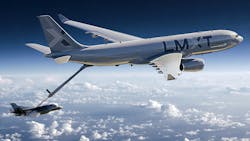Lockheed Plan Involves US-Built A330 Aircraft
Lockheed Martin committed to manufacture its new LMXT strategic tanker aircraft in Mobile, Ala., and Marietta, Ga. The LMXT was unveiled in September as Lockheed’s entry in the U.S. Air Force's KC-Y Program – an effort to select a new refueling aircraft for fighter jets.
The aircraft design is based on the Airbus A330 Multi Role Tanker Transport (MRTT), already in use by 14 nations to refuel fighter, transport, and maritime patrol aircraft. Lockheed proposed an earlier version of the design, but the U.S. Dept. of Defense has preferred the Boeing-design KC-135 and KC-46 tankers.
The U.S. Air Force is seeking a “bridge” tanker model to replace aircraft in the current fleet until a new tanker design is designed for operations in contested airspace.
If selected, the LMXT would mean that a third Airbus model – the wide-body A330 – would be assembled at that company’s Mobile, Ala., operation, where the narrow-body A320 and A220 commercial jets are assembled.
Another phase of the LMXT program would involve converting those A330 commercial jets for military service at the Lockheed Martin Aeronautics' Marietta, Ga. operation, where the C-130J Super Hercules final production is carried out and the F-35 Lightning II center wings are assembled.
Since 2018, Lockheed Martin and Airbus have had a ‘memorandum of agreement’ to explore aerial-refueling technologies fir any refueling capacity shortfalls for the USAF. The LMXT is a result of this MOA, and expansion at the Alabama and Georgia plants is described by Lockheed as a “natural progression.”
Improvements to the MRTT foreseen with the new LMXT would include greater range and fuel-offload capacity than current tankers; a proven, “fly-by-wire” refueling boom; a fully automatic boom/air-to-air refueling system (A3R); and combat-proven advance camera and rear-vision systems; among others.
